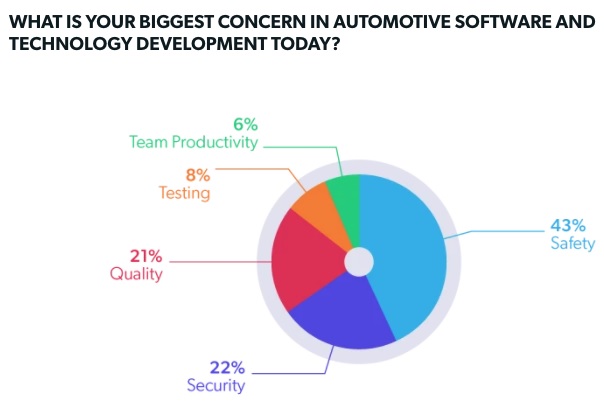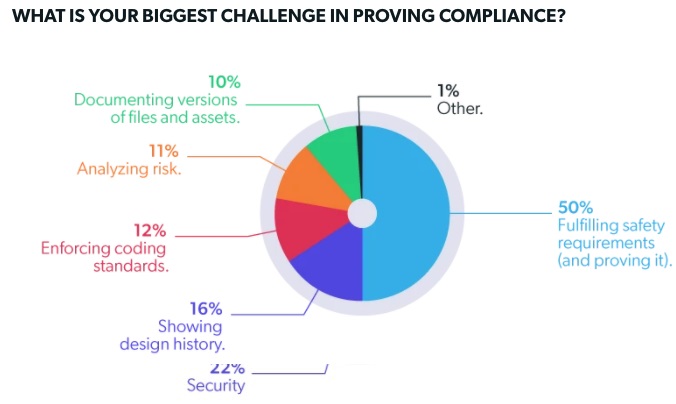Perforce Software
Software-fueled innovation is radically transforming the way by which industries operate and grow — especially the automotive industry. By 2027, the automotive software market is predicted to hit $43.5 billion, which is more than double its $18.5 billion market reported in 2019. As more manufacturers rely on software components to power the next generation of connected and autonomous vehicles, development teams will undoubtedly face many challenges associated with new safety and security regulations, design and IP management and team productivity.
To better understand this growing market's emerging challenges and concerns, Perforce Software surveyed 600+ automotive software development professionals to find out what's keeping them up at night. Here are the most interesting takeaways from the 2021 State of Automotive Software Development Survey Report, and considerations to navigate new challenges, improve quality and innovate faster.

Safety and Security Compliance Are Top Concerns Among Automotive Professionals
As the automotive industry transforms into an amalgam of electric, autonomous and hybrid vehicles, the market will undoubtedly experience significant disruption. Automotive vendors will be required to innovate and optimize older processes and inefficiencies to keep pace with the change. As such, the ability to comply with safety and security regulations and maintain high-quality outputs continues to present challenges—and, according to the survey, these were the top concerns reported with nearly half of the respondents (43%) citing safety.
Forward-looking automotive professionals are increasingly examining their ability to verify compliance with coding standards such as MISRA and AUTOSAR, functional safety standards with ISO 26262 and ISO 21448 (SOTIF), and the forthcoming automotive standard focused on cybersecurity risk, ISO 21434. To mitigate potential safety and security issues, and accelerate the compliance process, automotive software developers can use static code analysis (SCA). With SCA, developers can detect coding issues that other tools like compilers often miss — lowering overall costs and enabling teams to deliver their products on time.
Next to safety, security topped the list as the most reported concern for today's automotive professionals. Due to the growth of cyberattacks on connected vehicles and the increase in unauthorized access to onboard/offboard systems, this usually wouldn't be surprising. However, the respondents' feedback of just 22% reporting security as a top concern is. With the automotive landscape evolving at lightning speed, security must be an equal practice that development teams integrate into their CI/CD pipelines and consider upon each code change. By using the right Static Application Security Testing (SAST) tool, teams can solve software security vulnerabilities and enforce secure coding practices.
As the industry rapidly moves forward, safety, security and quality of the software will be critical to driving innovation without compromising standards. Professionals that invest in high-quality SCA and SAST tools will be the frontrunners leading the charge.

Software Development Productivity is Becoming Increasingly Challenging
Though software development teams have become more agile through methods and processes such as TDD (test driven development), model-driven development and automatic code generation, the report revealed that team productivity has become a growing challenge. Professionals' top concerns included a lack of integration between disparate teams in parallel development, the need to better manage design and IP assets, and long quality assurance cycles that end up delaying feedback and triggering extended-release cycles. Additionally, as the automotive industry shifts from hardware to software, teams are having difficulty time managing both hardware and software design and code assets.
Fortunately, there are tools developers can use to tackle these issues. Employing a proper version control system (VCS) can improve productivity by providing a scalable, secure, single source of truth to manage and iterate digital assets across teams. At the same time, software analysis tools with capabilities like incremental analysis can help optimize QA cycles and enable continuous fast feedback.

Teams Express Interest in Leveraging Game Development Technology
The 2021 State of Automotive Software Development Survey Report also indicated a growing interest in game development technology for many applications including digital twins, product testing, prototyping, marketing and AR/VR. In particular, the way game engines are contributing to new functionalities of digital twins are quickly emerging and game engines, like Unreal Engine, boast sophisticated visualization capabilities that make them the perfect solution for enhancing these simulations.
The digital twin software of the past was highly technical and often required an engineering background to comprehend it fully. With game engines, teams improve accessibility, the quality of their simulations and unlock entirely new applications for them. Certain manufacturers, like Audi, for instance, use game engines and real-world physics to simulate the design of new vehicles and create more immersive experiences — opening up the utility of the digital twin to a greater audience including corporate executives, marketing and sales teams, and even consumers.
While most automotive teams have yet to use game engines, 50% of respondents expressed interest in using them in the coming months or years. We predict this number will rise as automotive teams continually seek to enhance the quality of their vehicles and accelerate their time to market. When it does rise, teams will face new challenges associated with having much larger binary assets — an issue solved by a proper version control system.
Over the next decade, it's expected that the automotive market will undergo its most extreme transformation due to growing reliance on software and rapid technology advancements. Among many things, the integration of artificial intelligence and machine learning will greatly expedite productivity, data intelligence and develop processes to support the various stages in automotive software development cycles. As such, it will become critical for automotive software developers to stay on top of the latest regulations and standards related to safety, security and quality.
To be successful today and in the future, automotive vendors must employ strategic tools throughout the entire development life cycle to outperform competitors and stay agile in the evolving industry:
■ Static code analysis (SCA) and static application security testing (SAST) tools to ensure safe, secure and reliable software.
■ Version control software (VCS) and project management tools to manage consistently growing code bases and improve software development team productivity.
■ Game engine technologies to improve digital twin visualizations and their utility.
■ An application lifecycle management (ALM) solution to document when requirements are fulfilled, tests are initiated and bugs are resolved




